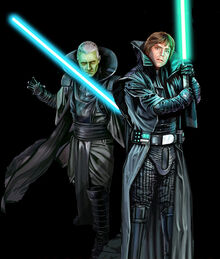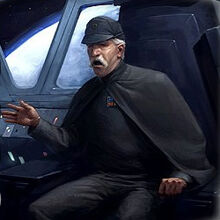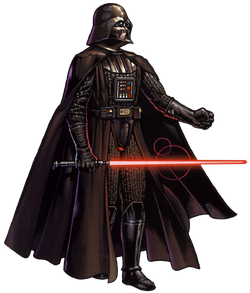| | |
Supreme Commander, also referred to as Supreme Commander of the Imperial Forces, Supreme Commander of the Imperial Fleet, Supreme Fleet Commander, Supreme Commander of the Imperial Military or simply Commander of the Imperial Fleet was a title held by a dignitary or senior officer who exercised supreme control over the Imperial Military. Within the Galactic Empire's power structure, the title designated the second-highest official, but the position would later be held by the heads of state of Thrawn's confederation and the Imperial Remnant.
Darth Vader was the first to hold the office of Supreme Commander under the Galactic Empire, and held authority over the entirety of the Imperial Military scattered in Imperial Space. The position continued to occupy a prominent place in the post-Endor Empire, being notably assumed by Thrawn and later Gilad Pellaeon, who also held the duties and responsibilities of head of state of their territories. During the Imperial Civil War, several warlords claimed the mantle of Supreme Commander.
History
Before Endor
Sometime following the Galactic Empire's ascension in the Clone Wars' aftermath, Emperor Palpatine appointed his handpicked right-hand, Darth Vader, to the office of Supreme Commander,[2] charging him with maintaining order throughout Imperial Space and leading the Imperial Military in its major operations,[1] such as the Reconquest of the Rim and the Great Jedi Purge.[3] As such, the Dark Lord of the Sith personally supervised a number of early Imperial campaigns, including two pacifications of Kashyyyk,[4][5], the quelling of the Vaklin insurgency,[6] the disastrous Shrouded Offensive,[7] and the Battle of Callos.[8] Throughout his tenure, the cyborg retained direct command of the 501st Legion, whose actions at his behest earned them the nickname of "Vader's Fist".[9] Lord Vader's position also allowed him to select the very best Imperial officers and crew to serve aboard his first flagships,[10] the Imperial-class Star Destroyers Exactor and Devastator respectively.
As part of expanding his and Palpatine's dominions, Darth Vader also brought the Noghri, a formidable warrior people, into the Empire's service as the elite Noghri Death Commandos.[11] He also oversaw the training and operations of the Inquisitorius, as well as their hunt for the last Jedi Knights.[12]
His duties and powers were not limited to command on the field, however. As part of the Emperor's purge,[13] Lord Vader played a key role in vanquishing traitors within the Empire's own ranks, which included preventing mutinies such as General Gentis' coup.[14] He also owned the Empirical,[15] a modified cruiser which housed a mobile laboratory used to conduct experiments and studies on prisoners and unique alien species, which he briefly entrusted to Lieutenant Rom Mohc for the Dark Trooper Project.[16] The vessel was rumored to be part of a fleet of such vessels under the Supreme Commander's command.[15] Circa 1 BBY, Lord Vader commissioned the Imperial Biological Weapons Division to secretly re-create a dangerous viral agent as Imperial bioweapons Project I71A aboard the Imperial I-class Star Destroyer Vector. The Supreme Commander had hoped to weaponize the pathogen and use it to eradicate the growing number of insurgents and freedom-fighters, but things eventually went awry and the program failed.[17]
Despite his involvement as an overseer in the Death Star project since early on,[18] the cyborg's position was of no relevance within the battle station's own chain-of-command, with Governor Wilhuff Tarkin - Grand Moff of the Oversector Outer - serving as commander,[19] while Lord Vader stood by him as Emperor Palpatine's envoy.

As the Empire retaliated against the Rebellion in the aftermath of the Battle of Yavin, Emperor Palpatine consolidated Lord Vader's powers as Supreme Commander, formally conferring the latter military, political and administrative authority second only to that of his master; the changes to office were subsequently announced in a communique by Lord Ars Dangor.[20] Following the Imperial Advisor's holomessage, the Emperor's lieutenant assembled the armada known as Death Squadron to strike back at the Rebel Alliance for the Yavin debacle. For his pursuit of the elusive Rebel Fleet, Lord Vader selected the Executor, the first Executor-class Star Dreadnought and the largest war vessel in the galaxy, to be his flagship.[21]
For the next three years and more, Lord Vader hunted down the Rebels—and in particular, his son Jedi Knight Luke Skywalker—all across the known galaxy, leading the Executor and her attached armada of Star Destroyers through the battles of Derra IV and Hoth as well as other campaigns, which saw him scoring notable victories and hounding his quarry wherever they hid.
On the Emperor's behalf, the Supreme Commander also sanctioned progress on several programs that impressed him, believing they could potentially change the course of the ongoing conflict in the Empire's favor. As such, Lord Vader personally authorized continued progress on General Rom Mohc's Dark Troopers[22] and inspecting Grand Admiral Demetrius Zaarin's TIE/D Defender.[23] In addition, the Sith Lord was tasked with keeping tabs on the development of the Death Star II above Endor.
Lord Vader also helped handle the coup headed by the treacherous Admiral Zaarin,[24] and was also left as interim power and protector of the Imperial Centre in the occasional absence of Palpatine in the months that encompassed the preparations for the Battle of Endor.[25] Although Lord Vader did not command directly at Endor, it appears that the Imperial Fleet believed that he was in charge, and it was his second-in-command, Admiral Firmus Piett, who directed the naval aspect of the confrontation with the Rebellion from the bridge of Executor.
After Endor
- "My father's destiny is my own."
- ―Luke Skywalker submits to serving the reborn Palpatine, taking Vader's title as the Empire's new Supreme Commander
Vader's death, along with that of Palpatine, threw the Empire into turmoil. After Endor, it is unclear whether any new Supreme Commander was appointed by any of the factions claiming to rule the Empire, and no obvious leader emerged until Grand Admiral Thrawn returned from the Unknown Regions[27]

After Thrawn's death at Bilbringi, the military hoped to appoint a new Grand Admiral, but the struggle for power between Imperial factions precipitated a civil war, out of which emerged the "reborn" Palpatine in a series of clone bodies, ruling from the Deep Core world of Byss. Against this background, Rebel hero Luke Skywalker took up his father's old post of Supreme Commander, part of a remarkable battle of wills between Palpatine and the Jedi Master. Palpatine knew that Luke was attempting to bring down the Empire from the inside, and Luke knew that Palpatine was hoping to seduce him to the dark side of the Force. As Supreme Commander, Luke deliberately fought a wasteful and destructive campaign designed to cripple the Imperial war machine and ensured the destruction of the World Devastators; although it seemed for a time that Palpatine's machinations had nevertheless eclipsed the good man that he was, threatening to plunge the galaxy into a new dark age. Utlimately, the son of Anakin Skywalker returned to the light, and joined with his sister Leia Organa Solo and his unborn nephew Anakin Solo to destroy the tyrant.[28]
The demise of Palpatine's clone and Skywalker's return to the New Republic did not, however, prompt a crisis to compare with that which had ensued after Endor; command passed smoothly to Sedriss QL[29], a Force-adept Imperial, as well as a distant descendant of the Sith Lord Ulic Qel-Droma,[30] with the rank of Military Executor.[31]
Be that as it may, Executor Sedriss took over Supreme Commander Skywalker's role in charge of the galaxywide campaign code-named Operation Shadow Hand, and continued in this capacity when another, final clone of Palpatine awoke on Byss[29]. After Sedriss's death, another Dark Jedi, Xecr Nist, was appointed his successor[32], but was defeated by Skywalker and Kam Solusar.[33] After that, he became a prisoner of war and died in captivity following the destruction of Palpatine's final clone.[34]
Imperial reunification

It was instead Admiral Natasi Daala who next emerged to lead the Imperial war machine. After Imperial authorities decommissioned her crippled flagship, she appointed herself to a roving ambassadorial commission, uniting the rival warlords' forces by assassinating their leaders and combining their fleets under her command, with all the powers of a Supreme Commander or Military Executor and, to an extent, the trappings of an "Empress," such as a cadre of Royal Guards.[35]
Following the debacle at Yavin, Daala surrendered her command to Vice Admiral Gilad Pellaeon, who was soon after found serving the Moff Council as the titular "Supreme Commander of the Imperial Fleet".[35]
Pellaeon's evolving powers in this capacity were best demonstrated by his otherwise cautious proposal to the Moff Council in favor of peace with the New Republic in 19 ABY as compared to his far sterner approach to politics during the Yuuzhan Vong War[36], particularly following the fall of Bastion[37] Even with these consolidated powers, animosity between the military and civil sectors of Imperial politics would remain high, as evidenced by an attempted coup and Pellaeon's eventual assassination, both machinations of Moffs.[36] [38]
Imperial Space after the Pellaeon–Gavrisom Treaty
After peace was secured between the New Republic and Imperial Space in the form of the Pellaeon–Gavrisom Treaty[38], the position of Supreme Commander of the Imperial Fleet became one of the most important posts in the Imperial government. Pellaeon was the chief Imperial negotiator and signatory to the peace treaty, and by some means, he came to assume the rank of Grand Admiral and also the chairmanship of the Council of Moffs, thus making him effectively both the commander-in-chief of Imperial forces and Imperial head-of-state.[39]
As Grand Admiral Pellaeon had been the only Imperial Supreme Commander in the post-treaty era, it is unknown whether he wielded his authority as a constitutionally appointed magistrate, or through personal prestige and precedent. With the Imperial Remnant later a part of the Galactic Alliance, it was also unknown what political powers the Supreme Commander still retained. By 28 ABY, Pellaeon was already known specifically as Grand Admiral of the Imperial Fleet.[37]
Ascension to the post
The several Supreme Commanders who led the Imperial war machine came to power in a variety of different ways. Luke Skywalker served when Palpatine was reborn in a clone body[28] and as did Xecr Nist.[32] As Grand Admiral, Thrawn was the higest ranking remaining officer in the military, and Daala assumed command by killing off the thirteen most powerful warlords and taking control of their fleets. Daala later relinquished command to Pellaeon.[35]
Evolution of powers
At its inception, the title and position were granted to Darth Vader. It seems that in this capacity, Vader's powers were those of Commander-in-Chief of all Imperial forces, answering only to Emperor Palpatine. When Vader died at the Battle of Endor[40], the position officially seems to have disappeared as a successor or second-in-command was never made apparent. Indeed, the separation of the military from the state's civil government is made most apparent by the fact that those who immediately thereafter claimed the throne seemed to not claim or appoint anyone to this post.
The next confirmed usage of the title came in 10 ABY during the reign of Palpatine's clones. This time, though, it was Vader's son, Luke Skywalker, who assumed the title of Supreme Commander of Imperial Forces.[28]
List of known Supreme Commanders

- Darth Vader, 0 ABY–4 ABY
- Thrawn, 8–9 ABY (de facto)
- Luke Skywalker, 10 ABY
- Redd Wessel, 11 ABY
- Immodet, 11 ABY
- An Imperial officer, 11 ABY
- Natasi Daala, 12 ABY (de facto/de jure)
- Gilad Pellaeon, 12–30 ABY
- Morlish Veed, 130–138 ABY (de facto)
Behind the scenes
The title and its position and powers within the Imperial government have been an area of controversy and confusion. For the purposes of this article, the various titles are treated as one, but their powers over time have changed.
Appearances
Non-canon appearances
Sources
- Imperial Sourcebook
- Dark Empire endnotes
- A Guide to the Star Wars Universe, Second Edition, Revised and Expanded
- ° Star Wars: The Power of the Force toy line (1995)
Star Wars: Shadows of the Empire toy line (Pack: Darth Vader vs. Prince Xizor) (backup link)
- Star Wars: The Action Figure Archive
- A Guide to the Star Wars Universe, Third Edition, Revised and Expanded
- The Official Star Wars Fact File 5 THR 1-4: Grand Admiral Thrawn
- The Official Star Wars Fact File 82 WOR 1-2: World Devastators
- The Official Star Wars Fact File 125 PEL 1-4: Gilad Pellaeon
- The Complete Star Wars Encyclopedia
- Legacy Era Campaign Guide
- The Essential Guide to Warfare
- The Essential Reader's Companion
 The Imperial Warlords: Despoilers of an Empire, Part 1 on StarWars.com (backup link) (original link is obsolete)
The Imperial Warlords: Despoilers of an Empire, Part 1 on StarWars.com (backup link) (original link is obsolete) The Imperial Warlords: Despoilers of an Empire, Part 2 on StarWars.com (backup link) (original link is obsolete)
The Imperial Warlords: Despoilers of an Empire, Part 2 on StarWars.com (backup link) (original link is obsolete)- Star Wars Magazine 1
Notes and references
- ↑ 1.0 1.1 Dark Times—Fire Carrier 1
- ↑
Star Wars: Shadows of the Empire toy line (Pack: Darth Vader vs. Prince Xizor) (backup link)
- ↑ Dark Lord: The Rise of Darth Vader
- ↑ The New Essential Guide to Characters
- ↑ Star Wars: The Force Unleashed
- ↑ Purge – The Tyrant's Fist 2
- ↑ Darth Vader and the Cry of Shadows 3
- ↑ Star Wars: The Force Unleashed novelization
- ↑ Star Wars: Battlefront II
- ↑ The New Essential Guide to Characters
- ↑ Heir to the Empire
- ↑ Evasive Action: Recruitment
- ↑ Republic 78
- ↑ Darth Vader and the Ghost Prison 1
- ↑ 15.0 15.1 The Force Unleashed Databank
- ↑ The Force Unleashed Campaign Guide
- ↑ Death Troopers
- ↑ Star Wars: Episode III Revenge of the Sith
- ↑ Star Wars: Episode IV A New Hope
- ↑ Imperial Sourcebook
- ↑ Star Wars: Episode V The Empire Strikes Back
- ↑ Star Wars: Dark Forces
- ↑ Star Wars: TIE Fighter
- ↑ Star Wars: TIE Fighter
- ↑ Star Wars: Shadows of the Empire novel
- ↑ Dark Empire 2
- ↑ Heir to the Empire
- ↑ 28.0 28.1 28.2 Star Wars: Dark Empire
- ↑ 29.0 29.1 Dark Empire II 1
- ↑ The Official Star Wars Fact File 85 SED 1-4: Exekutor Sedress
- ↑ The Dark Side Sourcebook
- ↑ 32.0 32.1 Dark Empire II 4
- ↑ Empire's End audio drama
- ↑ The New Essential Guide to Characters
- ↑ 35.0 35.1 35.2 Darksaber
- ↑ 36.0 36.1 Specter of the Past
- ↑ 37.0 37.1 The New Jedi Order: Force Heretic I: Remnant
- ↑ 38.0 38.1 Vision of the Future
- ↑ The New Jedi Order: Dark Tide II: Ruin
- ↑ Star Wars: Episode VI Return of the Jedi

